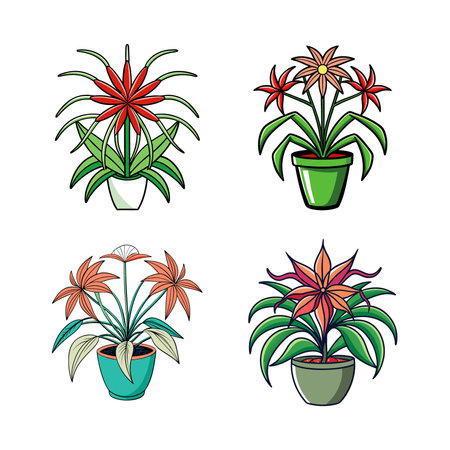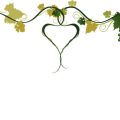1. Understanding Color Theory in Garden Design
Creating a stunning perennial garden isnt just about picking your favorite flowers—its also about choosing colors that work beautifully together. Understanding basic color theory can help you mix and match perennials to create eye-catching, harmonious combinations that thrive through the seasons.
What Is Color Theory?
Color theory is a guide for mixing and combining colors in a way thats visually appealing. In garden design, it helps you decide which flower and foliage colors will complement each other in your landscape. The most commonly used color schemes are complementary, analogous, and monochromatic.
Popular Color Schemes for Perennial Gardens
| Color Scheme | Description | Example Perennial Combinations |
|---|---|---|
| Complementary | Uses colors opposite each other on the color wheel. Creates strong contrast and visual interest. | Purple coneflowers (Echinacea) with yellow coreopsis; Blue salvia with orange daylilies |
| Analogous | Uses colors next to each other on the color wheel. Feels more harmonious and natural. | Pink phlox, red bee balm (Monarda), and purple asters |
| Monochromatic | Uses different shades and tones of a single color. Creates a soothing, unified look. | Light lavender catmint, medium purple Russian sage, deep violet salvia |
Using the Color Wheel in Garden Planning
The color wheel is your best friend when designing with perennials. Warm colors like red, orange, and yellow add energy and draw attention, while cool colors like blue, green, and purple bring calmness and depth. By placing warm-colored plants at focal points and cooler hues in the background or shady spots, you can guide the viewer’s eye through your garden naturally.
Tips for Getting Started:
- Start with one color scheme to keep things simple.
- Select perennials with overlapping bloom times for continuous color.
- Add foliage plants in silvery or dark green tones to balance bright flower colors.
- Use trial-and-error—gardens evolve over time!
With just a little knowledge of color theory, you’ll be able to build perennial beds that are not only full of life but also visually stunning from spring to fall.
2. Choosing the Right Perennials for Year-Round Interest
To create stunning color combinations with perennials, it’s important to choose plants that offer visual interest throughout the year. This means thinking beyond just flower color—consider bloom times, foliage hues, and how well each plant grows in your specific U.S. climate zone.
Understanding Bloom Times
Different perennials bloom at different times of the year. To maintain continuous color in your garden, choose a mix of early, mid, and late-season bloomers. This way, as one plant finishes blooming, another begins, keeping your garden vibrant from spring through fall.
| Bloom Season | Example Perennials |
|---|---|
| Spring | Creeping Phlox, Bleeding Heart, Columbine |
| Summer | Black-eyed Susan, Coneflower, Daylily |
| Fall | Aster, Sedum ‘Autumn Joy’, Japanese Anemone |
Foliage Matters Too
Perennials with colorful or textured leaves can add beauty even when they’re not blooming. Look for varieties with silver, burgundy, chartreuse, or variegated foliage to enhance your garden’s palette all season long.
Great Foliage Choices:
- Heuchera (Coral Bells): Available in shades from deep purple to lime green.
- Lamb’s Ear: Silvery leaves that add softness and contrast.
- Hosta: Varieties range from solid green to blue-gray and striped patterns.
Selecting Perennials by USDA Hardiness Zone
The U.S. has a wide range of growing zones—from Zone 3 in northern states like Minnesota to Zone 10 in southern Florida. Choose perennials suited for your region to ensure they thrive year after year.
| USDA Zone | Suggested Perennials |
|---|---|
| Zones 3–5 | Lupine, Peony, Siberian Iris |
| Zones 6–7 | Echinacea, Salvia, Shasta Daisy |
| Zones 8–10 | Lantana, Coreopsis, Gaillardia (Blanket Flower) |
Tip:
If you’re unsure about your zone, check the USDA Plant Hardiness Zone Map online or ask your local garden center for guidance. Matching the right plant to your zone is key for healthy growth and beautiful blooms year after year.
Create Layers of Color and Texture
Mix tall and short perennials together to add depth and variety. Use taller plants like Joe Pye Weed or Delphinium at the back of beds and shorter ones like Dianthus or Sedum in front. Grouping plants with complementary bloom times and leaf textures ensures visual appeal across all seasons.
Pro Tip:
Aim for a mix of three to five different perennials in one area that vary in height, bloom time, and color family—it creates a natural yet coordinated look that’s easy on the eyes.
Selecting the right combination of perennials will help you enjoy a colorful and dynamic garden all year long. With some planning around bloom time, foliage interest, and growing zones, you’ll be well on your way to creating stunning perennial displays that evolve beautifully through every season.
![]()
3. Combining Texture and Foliage for Visual Depth
When youre creating stunning color combinations with perennials, color is only part of the story. To truly elevate your gardens visual appeal, its important to also consider the texture and foliage of your plants. Mixing different leaf shapes, sizes, and textures adds depth and interest, making your color choices pop even more.
Why Texture Matters in Garden Design
Texture refers to the surface quality of a plant’s leaves—some are soft and fuzzy, others are smooth or glossy, and some may even have a coarse or rugged feel. When you combine contrasting textures, it creates visual layers that draw the eye across your garden beds.
Types of Leaf Textures
| Texture Type | Description | Examples |
|---|---|---|
| Fine | Delicate, feathery foliage that adds softness | Fern (Dryopteris), Coreopsis |
| Medium | Smooth-edged leaves with average size and shape | Echinacea, Salvia |
| Bold/Coarse | Large or thick leaves that stand out visually | Hosta, Ligularia |
Pairing Texture with Color for Impact
A smart way to enhance your perennial garden is by pairing bold-textured foliage with soft-colored flowers or vice versa. For example, the big, broad leaves of a Hosta can beautifully contrast with the small blooms of lavender or catmint. This makes each element stand out more clearly and gives your garden a balanced yet dynamic look.
Design Tips for Using Texture and Foliage
- Contrast is key: Combine fine-textured plants like yarrow with coarse-textured ones like ornamental rhubarb to create layers.
- Repeat textures: Use similar foliage types in different colors throughout your garden to unify the space without losing variety.
- Add year-round interest: Choose perennials with evergreen foliage or interesting winter textures to keep your beds attractive even when flowers fade.
Example Plant Combinations:
| Combination | Color Contrast | Texture Contrast |
|---|---|---|
| Lamb’s Ear + Black-eyed Susan | Silver-grey & bright yellow | Soft/fuzzy vs. medium/smooth |
| Coneflower + Russian Sage | Purple-pink & lavender-blue | Bold leaves vs. airy stems |
| Hosta + Astilbe | Deep green & soft pink/white blooms | Broad leaves vs. feathery plumes |
Using foliage as part of your design toolkit helps you create gardens that feel alive and layered—even when not everything is in bloom. By intentionally mixing leaf textures and shapes alongside your favorite perennial colors, you’ll build a landscape full of dimension and character.
4. Designing with Local Climate and Soil Conditions in Mind
When planning stunning color combinations with perennials, its essential to consider your local climate and soil conditions. Not all plants thrive everywhere, so understanding your regions unique environment helps you choose the right perennials that will not only survive but flourish together in vibrant displays.
Know Your Plant Hardiness Zone
The USDA Plant Hardiness Zone Map is a great starting point. It divides the country into zones based on average minimum winter temperatures. This helps you select perennials that can handle your region’s seasonal changes. For example, lavender may thrive in Zone 7 but struggle in colder Zone 4 areas.
Match Plants to Regional Rainfall Patterns
Rainfall varies greatly across the U.S., and choosing perennials suited to your area’s moisture levels is key for healthy growth and vibrant color. Drought-tolerant plants like Russian Sage or Coneflower are great for dry regions, while Astilbe and Ligularia prefer wetter environments.
Perennials by Rainfall Needs
| Rainfall Level | Recommended Perennials |
|---|---|
| Low (Southwest, parts of Texas) | Russian Sage, Yarrow, Coreopsis |
| Moderate (Midwest, Northeast) | Echinacea, Black-eyed Susan, Daylilies |
| High (Pacific Northwest, Southeast) | Astilbe, Hosta, Bee Balm |
Understand Your Soil Type
Sandy soils drain quickly and suit drought-tolerant plants. Clay soils retain moisture and nutrients but need good drainage to prevent root rot. Loamy soil is ideal for most perennials because it balances drainage and nutrient retention.
Common Soil Types and Suitable Plants
| Soil Type | Description | Best Perennials |
|---|---|---|
| Sandy | Fast-draining, low in nutrients | Lavender, Salvia, Sedum |
| Clay | Dense, holds water and nutrients | Iris, Daylily, Aster |
| Loam | Balanced texture and fertility | Peony, Phlox, Shasta Daisy |
Incorporate Native Plants for Low-Maintenance Color
Native perennials are naturally adapted to local conditions and often require less maintenance than non-native species. They also support local wildlife like pollinators and birds. For example, Purple Coneflower is native to many parts of the U.S. and pairs beautifully with Black-eyed Susans or Butterfly Weed for a colorful yet hardy combination.
Tip:
Check with your local extension office or native plant society to discover which native perennials work best in your area.
5. Seasonal Maintenance Tips to Keep Colors Vibrant
Keeping your perennial garden full of vivid color all season long doesnt just happen on its own. With a little seasonal care, you can make sure your flowers stay healthy and their colors remain bold and beautiful. Here’s how to keep those vibrant combinations going strong all year round.
Pruning for Health and Color
Regular pruning helps perennials focus energy on producing new blooms instead of maintaining old growth. It also helps keep plants tidy and encourages a longer blooming season.
- Spring: Trim back any dead or damaged stems left from winter. This gives your plants a fresh start.
- Summer: Deadhead spent blooms regularly to promote continuous flowering.
- Fall: Cut back perennials that have finished blooming, unless youre leaving seed heads for birds or winter interest.
Dividing Perennials to Rejuvenate Growth
Over time, perennials can become crowded and less productive. Dividing them every few years keeps them healthy and enhances their color performance.
| Perennial Type | When to Divide | Signs It’s Time |
|---|---|---|
| Daylilies | Early spring or late summer | Fewer flowers, center dies out |
| Hostas | Spring or early fall | Crowded clumps, reduced size |
| Black-eyed Susans | Every 3-4 years in spring or fall | Sparse blooming, patchy growth |
Feeding for Long-Lasting Color
Nutrients are key to keeping your perennials blooming with rich color. Use fertilizers at the right time and in the right amounts for best results.
Fertilizing Tips by Season:
- Spring: Apply a balanced slow-release fertilizer (like 10-10-10) when new growth appears.
- Mid-summer: Give flowering perennials a boost with a high-phosphorus fertilizer to support more blooms.
- Fall: Avoid fertilizing late in the season; instead, add compost or mulch to enrich the soil naturally for next year.
A Quick Seasonal Checklist
| Season | Main Tasks |
|---|---|
| Spring | Prune dead growth, divide overcrowded plants, fertilize early growth |
| Summer | Deadhead spent blooms, apply mid-season fertilizer, monitor watering needs |
| Fall | Cut back finished plants, divide if needed, apply mulch or compost |
| Winter (Prep) | Add protective mulch, plan for next seasons color combos |
A little attention each season goes a long way toward keeping your perennial garden bursting with color. By pruning, dividing, and feeding at the right times, you’ll enjoy healthy plants and stunning combinations throughout the year.


